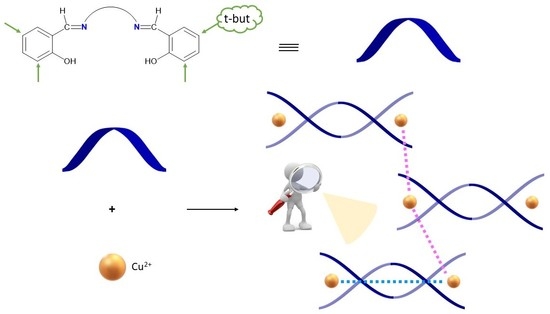Schiff Bases Functionalized with T-Butyl Groups as Adequate Ligands to Extended Assembly of Cu(II) Helicates
Abstract
1. Introduction
2. Results and Discussion
2.1. Synthesis and Characterization of the Ligands H2L1 and H2L2
2.2. Synthesis and Characterization of the Copper Complexes
Anode: 2 Cu → 2 Cu2+ + 4 e−
Global: 2 (L1|2)2− + 2 Cu2+ → Cu2(L1|2)2
X-ray Structures
2.3. Magnetic Properties of Helicates
3. Materials and Methods
3.1. Synthesis and Characterization of the Schiff Base Ligands H2L1 and H2L2
3.2. Synthesis and Characterization of the Neutral Copper(II) Dihelicates
3.3. X-ray Crystallography
3.4. EPR Spectroscopy
3.5. Magnetic Susceptibility Measurements
4. Conclusions
Supplementary Materials
Author Contributions
Funding
Institutional Review Board Statement
Data Availability Statement
Acknowledgments
Conflicts of Interest
References
- Fernández-Fariña, S.; Martínez-Calvo, M.; Maneiro, M.; Seco, J.M.; Zaragoza, G.; González-Noya, A.M.; Pedrido, R. Two Synthetic Approaches to Coinage Metal(I) Mesocates: Electrochemical versus Chemical Synthesis. Inorg. Chem. 2022, 61, 14121–14130. [Google Scholar] [CrossRef] [PubMed]
- Lehn, J.M.; Rigault, A.; Siegel, J.; Harrowfield, J.; Chevrier, B.; Moras, D. Spontaneous Assembly of Double-Stranded Helicates from Oligobipyridine Ligands and Copper(I) Cations: Structure of an Inorganic Double Helix. Proc. Natl. Acad. Sci. USA 1987, 84, 2565–2569. [Google Scholar] [CrossRef] [PubMed]
- McTernan, C.T.; Ronson, T.K.; Nitschke, J.R. Selective Anion Binding Drives the Formation of AgI8L6and AgI12L6Six-Stranded Helicates. J. Am. Chem. Soc. 2021, 143, 664–670. [Google Scholar] [CrossRef]
- Hannon, M.J.; Childs, L.J. Helices and Helicates: Beautiful Supramolecular Motifs with Emerging Applications. Supramol. Chem. 2004, 16, 7–22. [Google Scholar] [CrossRef]
- Albrecht, M. “Let’s Twist Again”—Double-Stranded, Triple-Stranded, and Circular Helicates. Chem. Rev. 2001, 101, 3457–3497. [Google Scholar] [CrossRef]
- Piguet, C.; Bernardinelli, G.; Hopfgartner, G. Helicates as Versatile Supramolecular Complexes. Chem. Rev. 1997, 97, 2005–2062. [Google Scholar] [CrossRef] [PubMed]
- Cooke, D.J.; Cross, J.M.; Fennessy, R.V.; Harding, L.P.; Rice, C.R.; Slater, C. Steric Control of the Formation of Dinuclear Double Helicate and Dinuclear Meso-Helicate Assemblies. Chem. Commun. 2013, 49, 7785–7787. [Google Scholar] [CrossRef]
- Ronson, T.K.; Adams, H.; Riis-Johannessen, T.; Jeffery, J.C.; Ward, M.D. Mixed Ligand Helicates and Mesocates. New J. Chem. 2006, 30, 26–28. [Google Scholar] [CrossRef]
- Mayans, J.; Font-Bardia, M.; Di Bari, L.; Arrico, L.; Zinna, F.; Pescitelli, G.; Escuer, A. From Mesocates to Helicates: Structural, Magnetic and Chiro-Optical Studies on Nickel(II) Supramolecular Assemblies Derived from Tetradentate Schiff Bases. Chem. Eur. J. 2018, 24, 7653–7663. [Google Scholar] [CrossRef]
- Fernández-Fariña, S.; Velo-Heleno, I.; Carballido, R.; Martínez-Calvo, M.; Barcia, R.; Palacios, Ò.; Capdevila, M.; González-Noya, A.M.; Pedrido, R. Exploring the Biological Properties of Zn(II) Bisthiosemicarbazone Helicates. Int. J. Mol. Sci. 2023, 24, 2246. [Google Scholar] [CrossRef]
- Ono, T.; Ishihama, K.; Taema, A.; Harada, T.; Furusho, K.; Hasegawa, M.; Nojima, Y.; Abe, M.; Hisaeda, Y. Dinuclear Triple-Stranded Helicates Composed of Tetradentate Ligands with Aluminum(III) Chromophores: Optical Resolution and Multi-Color Circularly Polarized Luminescence Properties. Angew. Chem. Int. Ed. 2021, 60, 2614–2618. [Google Scholar] [CrossRef] [PubMed]
- Van Craen, D.; Kalarikkal, M.G.; Holstein, J.J. A Charge-Neutral Self-Assembled L 2 Zn 2 Helicate as Bench-Stable Receptor for Anion Recognition at Nanomolar Concentration. J. Am. Chem. Soc. 2022, 144, 18135–18143. [Google Scholar] [CrossRef] [PubMed]
- Gunnlaugsson, T.; Hegarty, I.; Barry, D.; Byrne, J.P.; Kotova, O. Formation of Lanthanide Luminescent Di-Metallic Helicates in Solution Using a Bis-Tridentate (1,2,3-Triazol-4-Yl)-Picolinamide (Tzpa) Ligand. Chem. Commun. 2023. [Google Scholar] [CrossRef]
- Kalinke, L.H.G.; Rabelo, R.; Valdo, A.K.; Martins, F.T.; Moliner, N.; Ferrando-soria, J.; Julve, M.; Lloret, F.; Cano, J.; Cangussu, D. Trinuclear Cobalt(II) Triple Helicate with a Multidentate Bithiazolebis(Oxamate) Ligand as a Supramolecular Nanomagnet. Inorg. Chem. 2022, 61, 5696–5700. [Google Scholar] [CrossRef]
- Diego, R.; Pavlov, A.; Darawsheh, M.; Aleshin, D.; Nehrkorn, J.; Nelyubina, Y.; Roubeau, O.; Novikov, V.; Aromí, G. Coordination [CoII2] and [CoIIZnII] Helicates Showing Slow Magnetic Relaxation. Inorg. Chem. 2019, 58, 9562–9566. [Google Scholar] [CrossRef]
- Gao, X.; Li, L.; Sun, W.; Chen, P. Crystallization and Single Molecule Magnetic Behavior of Quadruple-Stranded Helicates: Tuning the Anisotropic Axes. Dalton Trans. 2020, 49, 2843–2849. [Google Scholar] [CrossRef]
- Fabbrizzi, L. Beauty in Chemistry: Making Artistic Molecules with Schiff Bases. J. Org. Chem. 2020, 85, 12212–12226. [Google Scholar] [CrossRef]
- Wang, Z.; Zhou, L.P.; Cai, L.X.; Tian, C.B.; Sun, Q.F. From a Mononuclear FeL2 Complex to a Fe4L4 Molecular Square: Designed Assembly and Spin-Crossover Property. Nano Res. 2021, 14, 398–403. [Google Scholar] [CrossRef]
- Wang, Y.T.; Li, S.T.; Wu, S.Q.; Cui, A.L.; Shen, D.Z.; Kou, H.Z. Spin Transitions in Fe(II) Metallogrids Modulated by Substituents, Counteranions, and Solvents. J. Am. Chem. Soc. 2013, 135, 5942–5945. [Google Scholar] [CrossRef]
- Hrabina, O.; Malina, J.; Kostrhunova, H.; Novohradsky, V.; Pracharova, J.; Rogers, N.; Simpson, D.H.; Scott, P.; Brabec, V. Optically Pure Metallohelices That Accumulate in Cell Nuclei, Condense/Aggregate DNA, and Inhibit Activities of DNA Processing Enzymes. Inorg. Chem. 2020, 59, 3304–3311. [Google Scholar] [CrossRef]
- Vázquez, M.; Taglietti, A.; Gatteschi, D.; Sorace, L.; Sangregorio, C.; González, A.M.; Maneiro, M.; Pedrido, R.M.; Bermejo, M.R. A 3D Network of Helicates Fully Assembled by π-Stacking Interactions. Chem. Commun. 2003, 3, 1840–1841. [Google Scholar] [CrossRef] [PubMed]
- Hooper, C.A.J.; Cardo, L.; Craig, J.S.; Melidis, L.; Garai, A.; Egan, R.T.; Sadovnikova, V.; Burkert, F.; Male, L.; Hodges, N.J.; et al. Rotaxanating Metallo-Supramolecular Nano-Cylinder Helicates to Switch DNA Junction Binding. J. Am. Chem. Soc. 2020, 142, 20651–20660. [Google Scholar] [CrossRef]
- Malina, J.; Hannon, M.J.; Brabec, V. Iron(II) Supramolecular Helicates Condense Plasmid DNA and Inhibit Vital DNA-Related Enzymatic Activities. Chem. Eur. J. 2015, 21, 11189–11195. [Google Scholar] [CrossRef] [PubMed]
- Cardo, L.; Nawroth, I.; Cail, P.J.; McKeating, J.A.; Hannon, M.J. Metallo Supramolecular Cylinders Inhibit HIV-1 TAR-TAT Complex Formation and Viral Replication in Cellulo. Sci. Rep. 2018, 8, 13342. [Google Scholar] [CrossRef] [PubMed]
- Wang, Y.; Wang, C.; Feng, Q.; Zhai, J.; Qi, S.; Zhong, A.; Chu, M.; Xu, D. Copper-Catalyzed Asymmetric 1,6-Conjugate Addition of in Situ Generated Para-Quinone Methides with B-Ketoesters. Chem. Commun. 2022, 58, 6653–6656. [Google Scholar] [CrossRef]
- Habeeb, J.J.; Tuck, D.G.; Walters, F.H. Direct Electrochemical Synthesis of Some Metal Chelate Complexes. J. Coord. Chem. 1978, 8, 27–33. [Google Scholar] [CrossRef]
- Rodríguez, A.; García-Vázquez, J.A. The Use of Sacrificial Anodes for the Electrochemical Synthesis of Metallic Complexes. Coord. Chem. Rev. 2015, 303, 42–85. [Google Scholar] [CrossRef]
- González-Barcia, L.M.; Romero, M.J.; González Noya, A.M.; Bermejo, M.R.; Maneiro, M.; Zaragoza, G.; Pedrido, R. “The Golden Method”: Electrochemical Synthesis Is an Efficient Route to Gold Complexes. Inorg. Chem. 2016, 55, 7823–7825. [Google Scholar] [CrossRef]
- Yusuf, T.L.; Oladipo, S.D.; Zamisa, S.; Kumalo, H.M.; Lawal, I.A.; Lawal, M.M.; Mabuba, N. Design of New Schiff-Base Copper (II) Complexes: Synthesis, Crystal Structures, DFT Study, and Binding Potency toward Cytochrome. ACS Omega 2021, 6, 13704–13718. [Google Scholar] [CrossRef]
- Wallis, M.J.; Min, H.; Lindoy, L.F.; Li, F. Investigating the Conformations of a Family of [M2L3]4+ Helicates Using Single Crystal X-Ray Diffraction. Molecules 2023, 28, 1404. [Google Scholar] [CrossRef]
- Jeffrey, G.A. An Introduction to Hydrogen Bonding; Oxford University Press: Oxford, UK, 1997. [Google Scholar]
- Cucos, P.; Tuna, F.; Sorace, L.; Matei, I.; Maxim, C.; Shova, S.; Gheorghe, R.; Caneschi, A.; Hillebrand, M.; Andruh, M. Magnetic and Luminescent Binuclear Double-Stranded Helicates. Inorg. Chem. 2014, 53, 7738–7747. [Google Scholar] [CrossRef] [PubMed]
- Pedrido, R.; López, M.V.; Sorace, L.; González-Noya, A.M.; Cwiklinska, M.; Suárez-Gómez, V.; Zaragoza, G.; Bermejo, M.R. The Coordination Preferences of Metal Centres Modulate Superexchange Coupling Interactions in a Metallo-Supramolecular Helical Assembly. Chem. Commun. 2010, 46, 4797–4799. [Google Scholar] [CrossRef] [PubMed]
- Palacios, M.A.; Díaz-Ortega, I.F.; Nojiri, H.; Suturina, E.A.; Ozerov, M.; Krzystek, J.; Colacio, E. Tuning Magnetic Anisotropy by the π-Bonding Features of the Axial Ligands and the Electronic Effects of Gold(I) Atoms in 2D {Co(L)2[Au(CN)2]2}: Nmetal-Organic Frameworks with Field-Induced Single-Ion Magnet Behaviour. Inorg. Chem. Front. 2020, 7, 4611–4630. [Google Scholar] [CrossRef]
- Peisach, J.; Blumberg, W.E. Structural Implications Derived from the Analysis Resonance Spectra of Natural of Electron and Paramagnetic Artificial. Arch. Biochem. Biophys. 1974, 165, 691–708. [Google Scholar] [CrossRef]
- Seebauer, E.G.; Buliba, E.P.; Scogin, D.A.; Gennis, R.B.; Belford, R.L. EPR Evidence on the Structure of the Copper(II)-Bacitracin A Complex. J. Am. Chem. Soc. 1983, 105, 4926–4929. [Google Scholar] [CrossRef]
- Sheldrick, G.M. Program for Scaling and Correction of Area Detector Data; University of Gottingen: Gottingen, Germany, 1996. [Google Scholar]
- Sheldrick, G.M. Crystal Structure Refinement with SHELXL. Acta Crystallogr. Sect. C Struct. Chem. 2015, 71, 3–8. [Google Scholar] [CrossRef]
- Macrae, C.F.; Bruno, I.J.; Chisholm, J.A.; Edgington, P.R.; Mccabe, P.; Pidcock, E.; Rodriguez-monge, L.; Taylor, R.; Van De Streek, J.; Wood, P.A. Mercury CSD 2.0—New Features for the Visualization and Investigation of Crystal Structures. J. Appl. Crystallogr. 2008, 41, 466–470. [Google Scholar] [CrossRef]


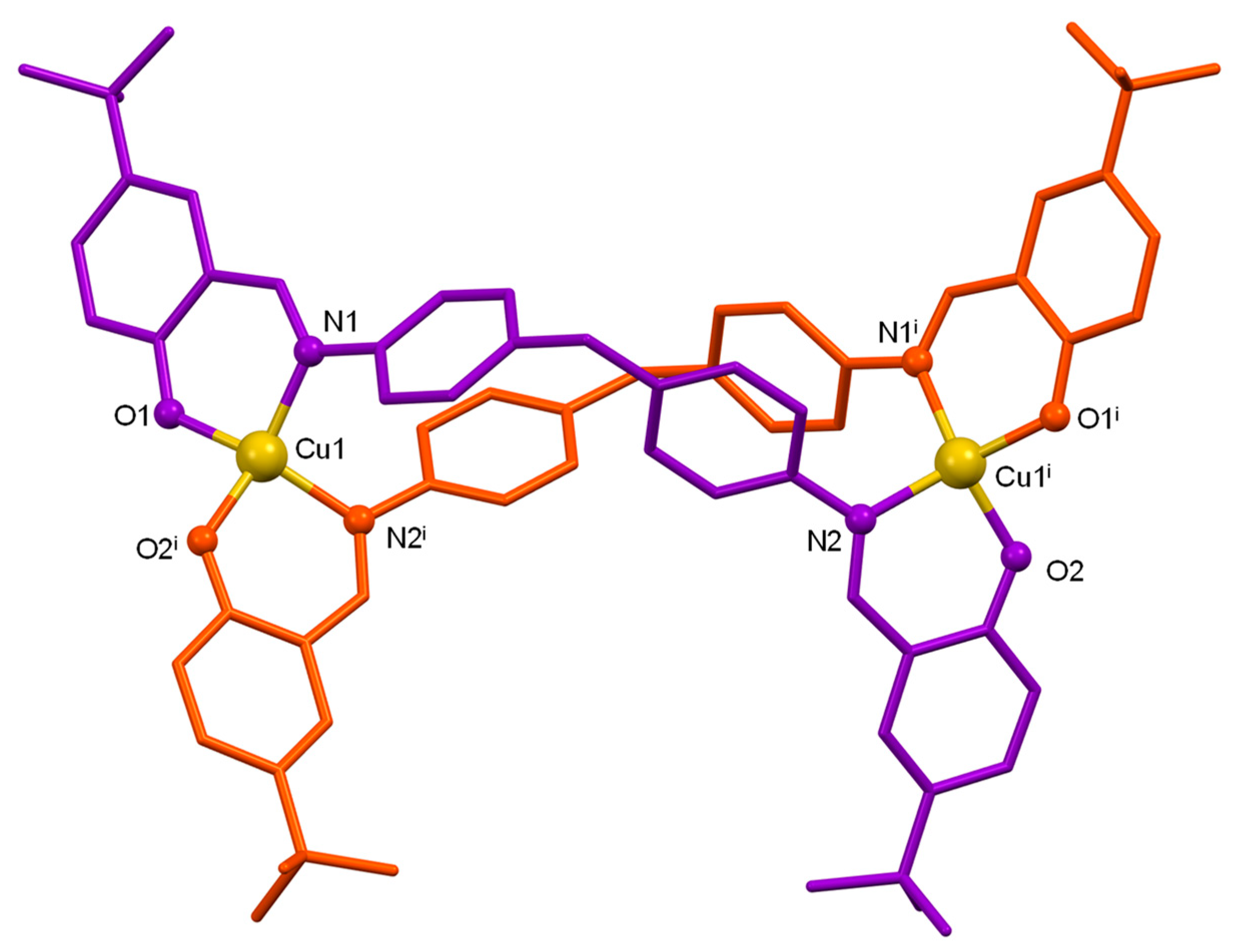

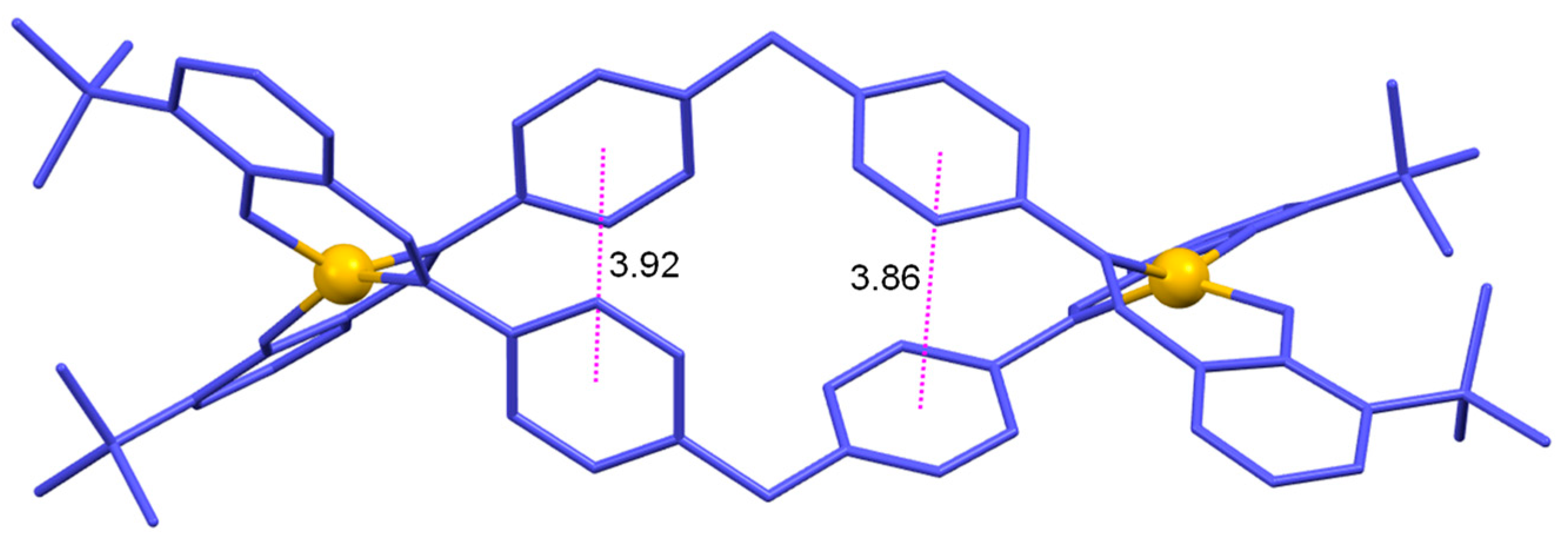
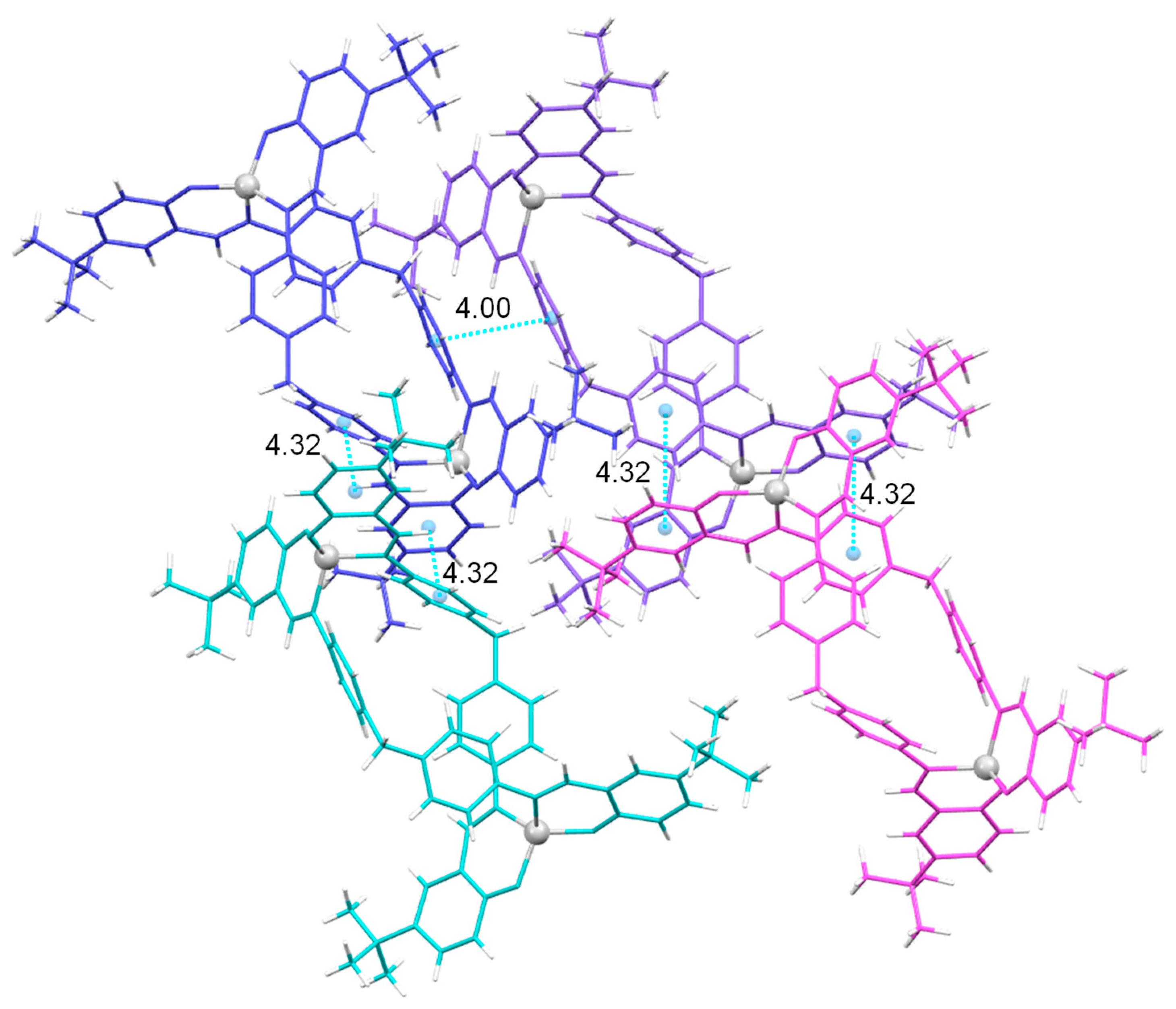
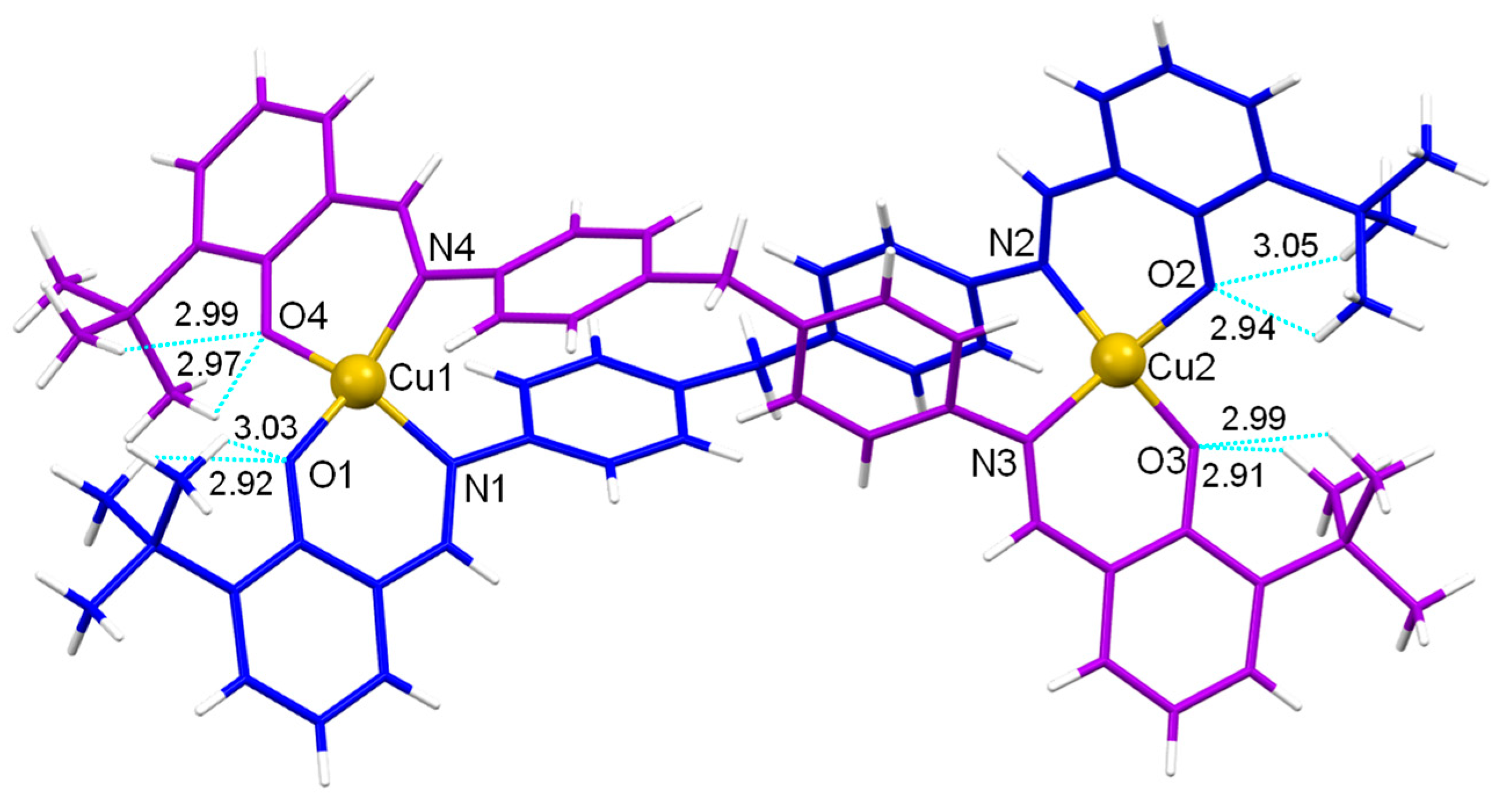
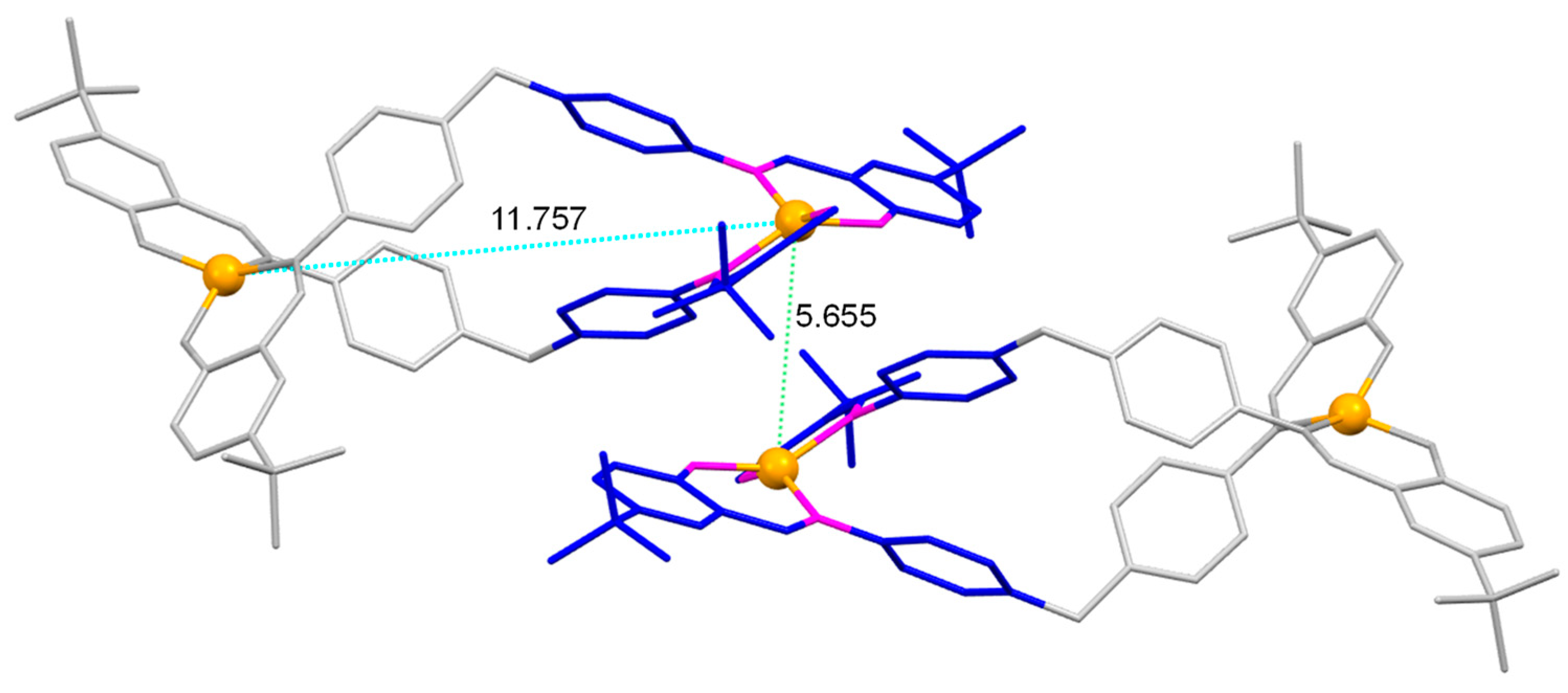
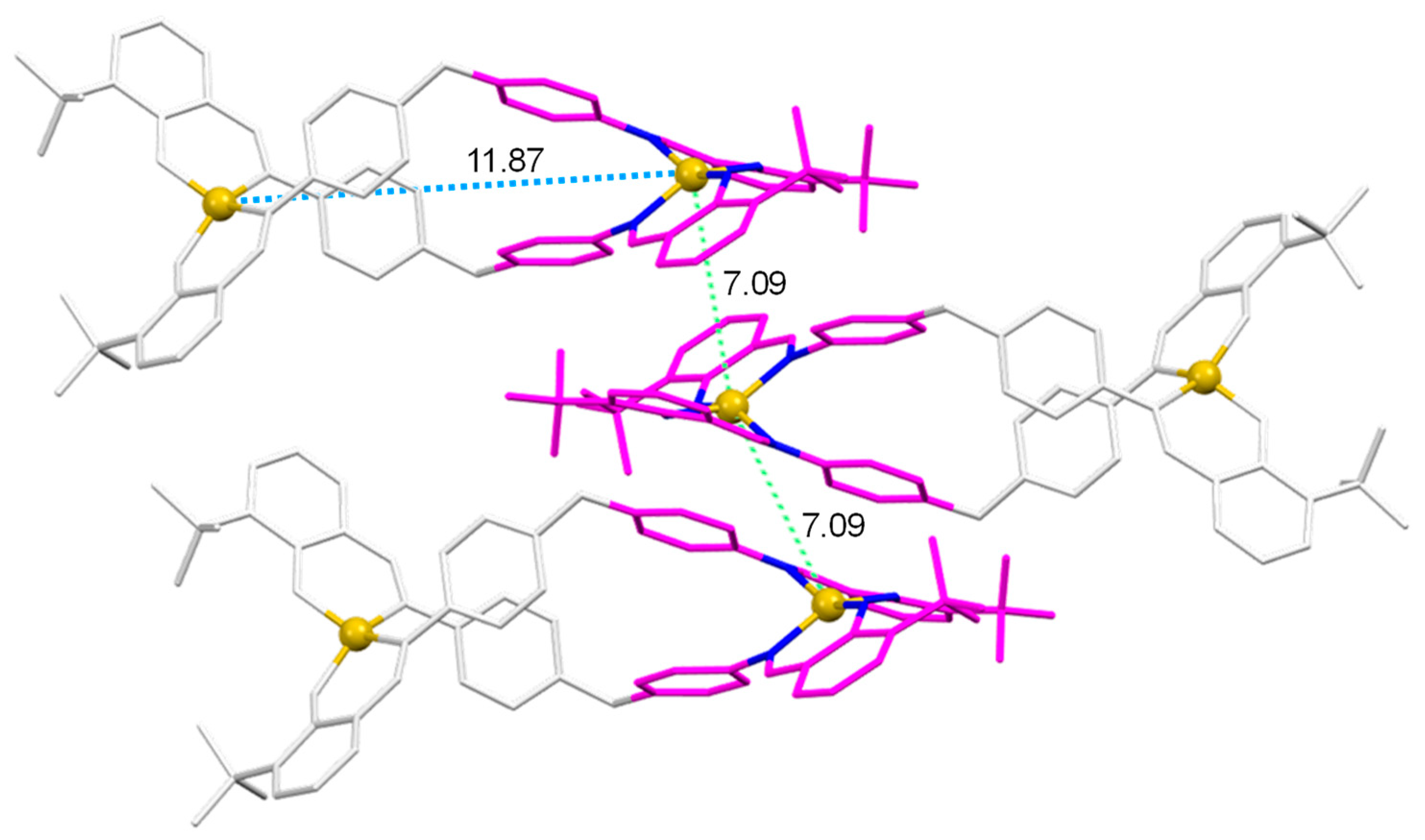

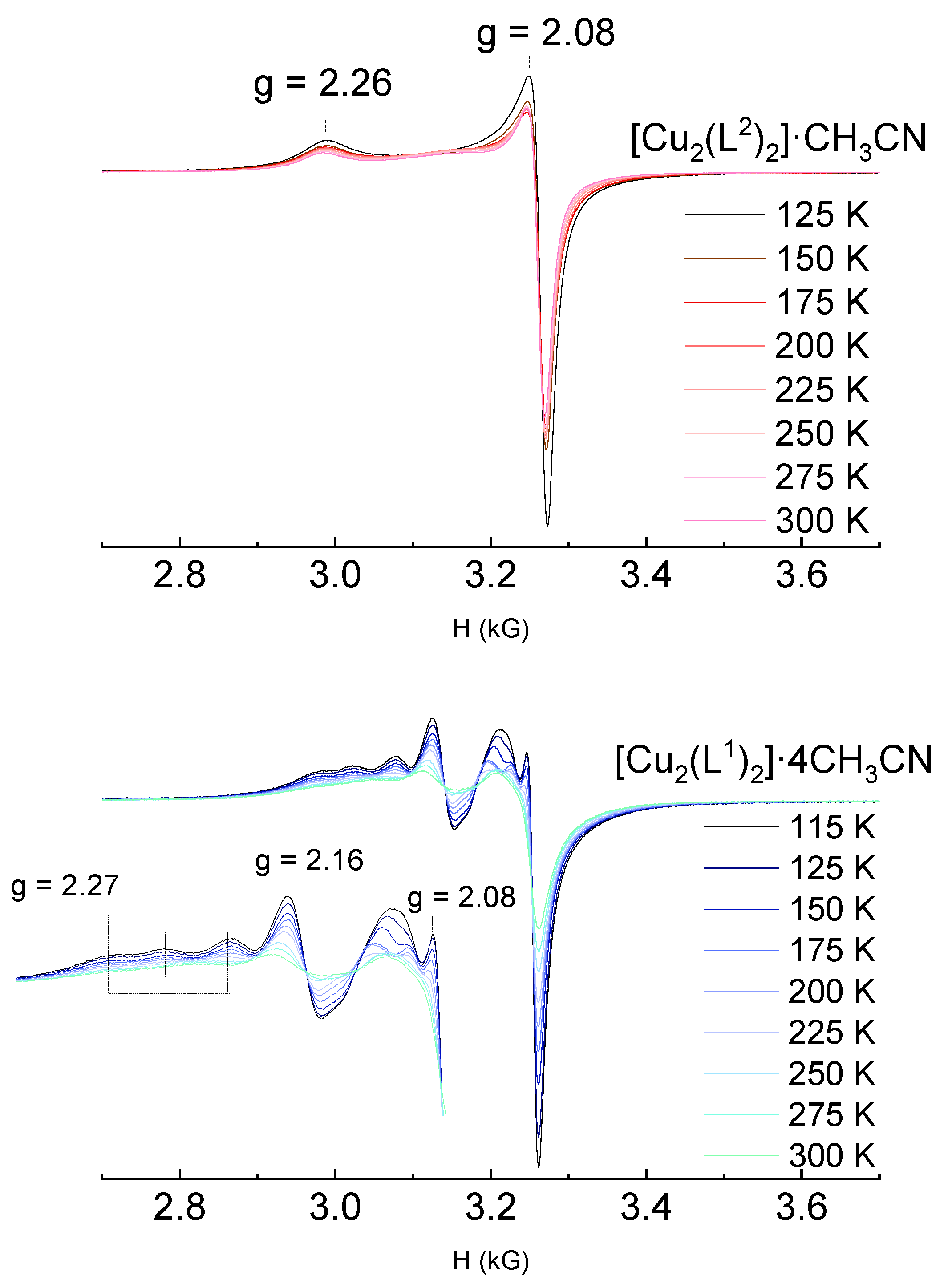
Disclaimer/Publisher’s Note: The statements, opinions and data contained in all publications are solely those of the individual author(s) and contributor(s) and not of MDPI and/or the editor(s). MDPI and/or the editor(s) disclaim responsibility for any injury to people or property resulting from any ideas, methods, instructions or products referred to in the content. |
© 2023 by the authors. Licensee MDPI, Basel, Switzerland. This article is an open access article distributed under the terms and conditions of the Creative Commons Attribution (CC BY) license (https://creativecommons.org/licenses/by/4.0/).
Share and Cite
Fernández-Fariña, S.; Velo-Heleno, I.; Martínez-Calvo, M.; Maneiro, M.; Pedrido, R.; González-Noya, A.M. Schiff Bases Functionalized with T-Butyl Groups as Adequate Ligands to Extended Assembly of Cu(II) Helicates. Int. J. Mol. Sci. 2023, 24, 8654. https://doi.org/10.3390/ijms24108654
Fernández-Fariña S, Velo-Heleno I, Martínez-Calvo M, Maneiro M, Pedrido R, González-Noya AM. Schiff Bases Functionalized with T-Butyl Groups as Adequate Ligands to Extended Assembly of Cu(II) Helicates. International Journal of Molecular Sciences. 2023; 24(10):8654. https://doi.org/10.3390/ijms24108654
Chicago/Turabian StyleFernández-Fariña, Sandra, Isabel Velo-Heleno, Miguel Martínez-Calvo, Marcelino Maneiro, Rosa Pedrido, and Ana M. González-Noya. 2023. "Schiff Bases Functionalized with T-Butyl Groups as Adequate Ligands to Extended Assembly of Cu(II) Helicates" International Journal of Molecular Sciences 24, no. 10: 8654. https://doi.org/10.3390/ijms24108654
APA StyleFernández-Fariña, S., Velo-Heleno, I., Martínez-Calvo, M., Maneiro, M., Pedrido, R., & González-Noya, A. M. (2023). Schiff Bases Functionalized with T-Butyl Groups as Adequate Ligands to Extended Assembly of Cu(II) Helicates. International Journal of Molecular Sciences, 24(10), 8654. https://doi.org/10.3390/ijms24108654







